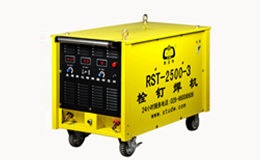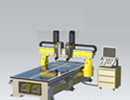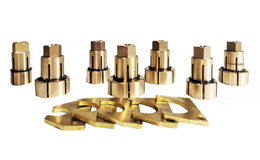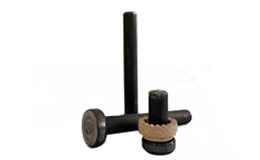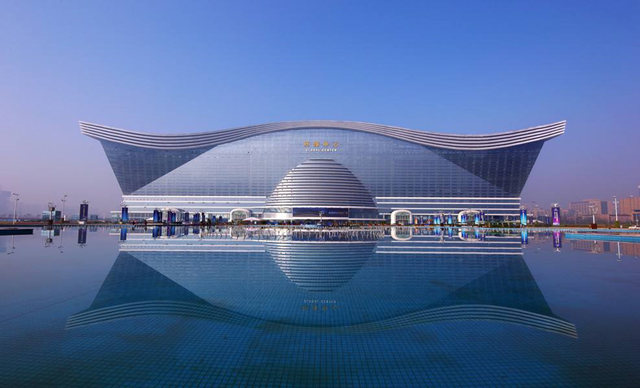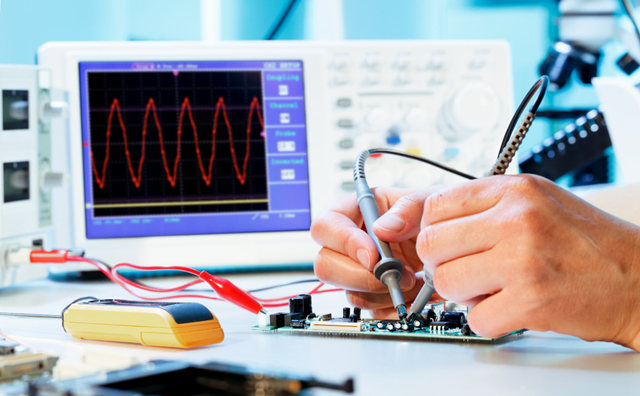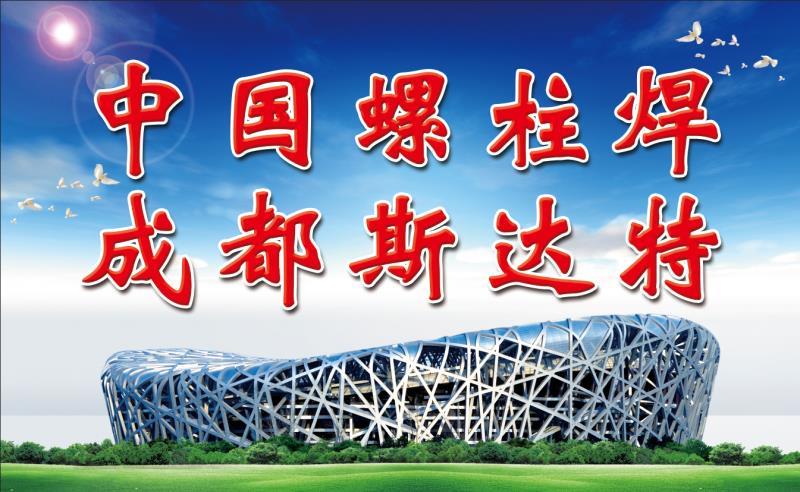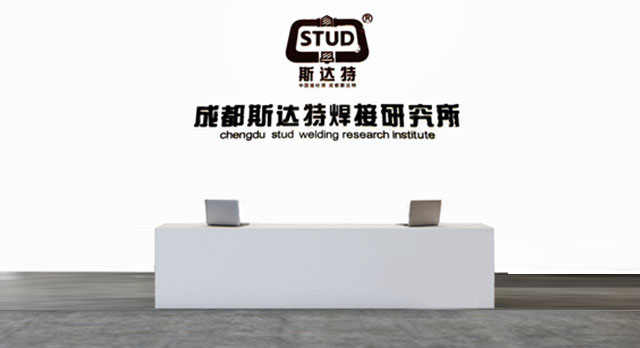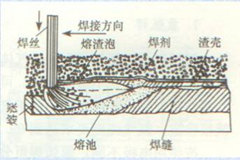Research of Stud Full-Penetration Welding
Research of Stud Full-Penetration Welding
(Chengdu Stud welding Research Institute Chengdu 610000)
Summary: The molten drop free transition is applied for Stud full-penetration welding based on the mechanism researching of arc stud welding. The gas and garbage which generated during welding are expelled by electromagnetic force and plasma flow force.
Keywords: Stud full-penetration welding Stud welding technology
1 Overview for Stud full-penetration welding
“Steel--concrete combination floor plate structure” is a fast developed technology in construction industry because of its large load capacity, high stiffness, good seismic performance, easy and fast construction, especially applied in high building, large gymnasium and gallery. The combination of steel girder, profiled steel sheet and reinforced concrete depends on stud(which is the connector with shear force). The full-penetration welding of stud welding have to be adopted in this case as Photo 1. The process of full-penetration welding is passing the stud through profiled steel sheet to weld on the steel girder into one.

PHOTO 1 Stud full-penetration welding schematic drawing
The largest difference of Stud full-penetration welding is the process of stud passing through the profiled steel sheet compare to normal stud welding. Besides, the common material of profiled steel sheet is galvanized steel sheet with paint on the steel girder, which make the welding more complicated. It is significant to research the full-penetration welding technology which will ensure the construction quality of “Steel--concrete combination floor plate structure” and improve FPY of stud welding.
2. Main issues of Stud full-penetration welding
2.1. The effect of zinc to Stud full-penetration welding
There are two solutions for stud piercing the profiled steel sheet:
a) . Perforating on the welding position of profiled steel sheet in advance, welding the stud on steel girder directly after construction site ready. The advantage is that the welding quality can be ensured, however, it is wasting time and work. This solution is not adopted at present.
b) . Welding the stud on steel girder after burning through the profiled steel sheet by electric arc. The advantage is same time of perforation of profiled steel sheet and stud welding. The main problem is how to clear or reduce the effect to welding quality from galvanization on profiled steel sheet. This method is adopted widely at present.
For anti-corrosion purpose, the profiled steel sheet of “Steel--concrete combination floor plate structure” is galvanized steel sheet usually which thickness is 06.~1.6mm. According to the YB9238 standard: the double sided zinc coating mass ≥275g/m2. The melting point of zinc is 420℃, the boiling point of zinc is 908℃. When Stud full-penetration welding, zinc is vaporized and oxidized by the high temperature arc rapidly, the zinc steam enlarge the pressure internal ferrule and splash, this lead to the undercut of weld seam easily; there will be air hole in the weld seam if the zinc steam is not clear totally; the thermal crack will be formed by low melting point co-crystallization which generated in the weld seam by zinc; porous material will be formed in the molten metal by ZnO. All above will affect the welding quality seriously and reduce the mechanical properties of welding point.
2.2 Coating on the steel girder
To anti-corrosion, the steel girder is coated(the coating is 0.03~1.00mm) in advance when applied in “Steel--concrete combination floor plate structure”. The coating is significant to the arc-starting and quality of stud welding. The circumstance will be more serious if there are zinc, sulphur and phosphorus etc in the coating because the chemical reaction of these elements will generate harmful chemical compounds which will bring air hole and crack in the weld seam.
The welding quality will be ensured easily if we clear the coating of welding position, however, this is difficult to carry out. This is a problem doubtless because the workers weld directly without any treatment of the steel girder at present.
2.3 The gap and clinker between the girder and profiled steel sheet
The clinker should not be existed between the girder and profiled steel sheet (the gap between the girder and profiled steel sheet should be ≤1mm) for Stud full-penetration welding. However, this is hard to be ensured because of the warp and deformation of the profiled steel sheet and engineering techniques. Some gap is even 10mm. It will affect the integral welding of stud, steel girder and profiled steel sheet and weld seam shaping if without adjustment.
3. Studying welding principle, finding the solution of avoidance and decrease of the welding defect
Two stage of Stud full-penetration welding: 1. burning through the profiled steel sheet; 2. integral welding of stud, steel girder and profiled steel sheet. Meanwhile, vaporization, decomposion of coating, clinker and oxide on the steel girder, exclusion of the dirt internal the welding pool are proceeding.
3.1 Shorten the time of burning through the profiled steel sheet by molten drop free transition
The most important thing is burning through the profiled steel sheet which depends on welding arc. However, electric arc is different status when the various type molten drop transition, and the amount and speed of electric arc is different either. So we should study the molten drop transition.
The two types of molten drop transition: short-circuiting transition and free transition
Short-circuiting transition: the connection of molten drop of stud head and welding pool. The electric arc is extinguished at the moment, and it will be inflamed again when molten drop fitting in the welding pool and separating from stud. So the combustion of arc is not continuous when short-circuiting transition of molten drop.
Free transition: the big molten drop falls into the molten pool freely. The long arc and high arc voltage is necessary. The combustion of arc is continuous and not affected by molten drop transition. The most difference of two transition is lift height (the distance between head of stud and steel girder). When the distance is small, it is short-circuiting transition; when the distance is enlarged, it is free transition.
The molten drop free transition should be applied for Stud full-penetration welding. The combustion arc is continuous and the temperature is 3000~4000℃(the core temperature is even over 5000℃). It is a stable high density power which can burn through the profiled steel sheet, vaporize, decompose coating, clinker and oxide on the steel girder. Its effect is much more better than which depends on the molten metal of positive pole. This is why the lift height should be increased when Stud full-penetration welding. However, the lift height should not be too large, just support the molten drop free transition properly. Along with the metal molten, the length of stud is getting short which is equivalent to increase the lift height; on the other hand, the magnetic blow and air hole will be generated if the lift height is too large.
3.2 The gas and garbage in welding pool are expelled by electromagnetic force and plasma flow force
Burning through the profiled steel sheet, vaporization, decomposion of coating, clinker and oxide on the steel girder depend on the stable high temperature arc; The gas and garbage which generated during welding are expelled by electromagnetic force and plasma flow force.
There are electromagnetic force, plasma flow force and dot force besides surface tension and gravity force on the molten drop. The electromagnetic force are generated and decomposed to radial direction and axial direction when the current through the molten drop as Photo 2. Axial direction Fcz is downward and accelerates the molten drop transition, takes pressure on welding pool when the diameter(dG) of arc root area is larger than the diameter (dD) of molten drop. The force Fcz is proportional to square of current value. Actually the gas which enters arc zone from upper is heated and ionized, generates large pressure which called plasma flow force on the welding pool by the drive and acceleration from Fcz because the electromagnetic force is not even on axial direction and with pressure difference as Photo 3. The plasma flow of electric arc is with very fast speed and acceleration which can reach hundreds meters per second1). The dynamic pressure in the centre line of arc is the most strong, the current is larger, the pressure is larger and the area is narrower, the dynamic pressure and beating action is stronger on the welding pool.


Photo2 The relationship between distribution of electromagnetic force and arc root area
Photo3 The schematic drawing of plasma flow
The molten drop free transition is important because the harmful substance can be removed easily when the welding starting (the welding pool and fusing fluids is small). The harmful substance will be removed hardly if the process is long because it is mixed with large quantity molten metal.
To meet the above request, a special ferrule is needed for full-penetration welding which should be thicker wall to avoid the explosion by more molten metal; also it should have larger air vent and gap between stud and ferrule to generate strong plasma flow to remove the gas and dirt rapidly during welding.
It is not easy to remove all the harmful substance. We suggest that increasing the insert speed of stud properly when welding finished. This will be very effective to the weld seam quality though the splash will be more.
3.3 Increasing the metal melting quantity to get continuous fillet weld
The quality request of continuous fillet weld of integral welding of stud, steel girder and profiled steel sheet is related with construction quality of steel structure and welding parameter setting besides the situation of burning through the profiled steel sheet, vaporization and decomposion of coating. The important reason is the gap between profiled steel sheet and steel girder which is up to the deformation of profiled steel sheet and construction quality. It will be serious specially welding on the second, third, fourth parts of overlapped profiled steel sheet. It is hard to get good weld seam if mechanical pressure, hammer-blow and spot welding are not adopted to make the gap ≤1mm. The elongation length of stud, welding current and welding time should be enlarged to increase the metal melting quantity to get continuous fillet weld. Incomplete fusion because of the small welding current or the short welding time or both which may output small power, meanwhile the melting quantity is less and the depth of preparation is not enough.
4 Formulating reasonable welding procedure, improving the FPY of stud welding
Our technician formulated the welding procedure and did the simulating experiment:
Stud welder: RST-2500-3 Welding current: 1430A
Stud: φ19×120mm,ML15 Welding time: 1.8s
Steel sheet: 14mm thickness, Q235 Lift height: 4mm
Galvanized plate: 1mm Elongation length: 5.5mm
The welding testing part sent to Southwest Jiaotong University, do the inspection as per ANS1/AWSD1·1—98, results as Table 1.
Table 1
| Diametermm | NO. | Weld seam appearance detection | Tensile test | Bending test 30° | Macro - metallographic | |||||||
| Overlap | Transversal crack | ≥0.5 mmUndercut |
N/mm2 | Fracture location | Welding foot break | Welding foot crack | Fusion | Air hole | Crack | Slag | ||
| 19 |
1 | 360°Existed | NO | NO | 407 | Mother board | GOOD | NO | NO | 0.5mm Two slag, maximum 0.5mm | ||
| 2 | 360°Existed | NO | NO | 407 | Mother board | GOOD | NO | NO | 0.2mm One slag, maximun 0.2mm |
|||
| 3 | 360°Existed | NO | NO | NO | NO | |||||||
| 4 | 360°Existed | NO | NO | NO | NO | |||||||
The results indicates: The welding procedure is reasonable because of the qualified weld seam appearance and mechanical properties. For researching the metallographical structure on the weld seam and the effect of coating on steel girder, we add the test of macro-metallographic though which is not existed in the related standard from China and America. The two testing parts both have slag. We pay high attention to it though the slag is very small. Is it the remaining material after the vaporization of coating on steel girder? The electromagnetic force and plasma flow force and special ferrule are emphasis to cleanse the welding pool when we formulating welding procedure.
According to the actual conditions, the origin welding procedure is adjusted and the test welding is done. Formal welding is done after the inspection as per JGJ81 standard. The welding studs are random checked as well. The welding inspection of studs is appearance check and mechanical properties check. The fillet weld of stud after welding should be continuous within 360°. The height of smallest welding foot should be >1mm, the width >0.5mm, the depth of undercut <0.5mm and without air hole and slag. The reason of these defect is the large gap between profiled steel sheet and steel girder, stud is not perpendicular to steel girder. This can be solved by repairing welding of manual welding. The mechanical properties of stud joint can meet the request of standard as well after repairing welding. Besides, the height tolerance of stud after welding is ±2mm which can reflect the performance of arc stud welding machine and the stability of welding parameter. The mechanical properties test of stud is bending 30°and tensile test. The crack and break should not be existed in the weld seam and heat-affected zone after bending 30°test. The stud should be wiped out if the defect existed. Re-welding on the original position after polishing the steel girder. This defect is because of the water-drop and moisture on the welding position(including stud arc junction and moisture ferrule) which can not be removed totally by electric arc. The fractured or slim position should not be appeared in the weld seam and heat-affected zone, in other word, the tensile strength of welding position should be over or equal to mother board. This is the advantage of total cross section stud welding.
Table 2 is stud welding technological parameter and parts of testing items which is not totally same as the technological parameter in simulating experiment. Besides the difference between actual conditions and simulating experiment, the other important reason is there are many uncertainty in construction site. For instance: the big or small gap between profiled steel sheet and steel girder, the slag, the uneven coating etc. The welding parameter should be adjusted according to the actual condition to make allowance for unfavourable occurrences. The welding parameter is not all the same even for same diameter stud in different construction site.
Table 2
Welder:RST-2500-3 Floating voltage:100V Stud:φ19×150mm
Profiled steel sheet:0.8mm(Zinc coating thickness:0.02mm)
| Testing parts NO. | Gap between profiled steel sheet and steel girder mm | Gap after compaction mm | Welding current A | Welding time s | Elongation lengthmm | Lift height mm | Appearance shaping | Bending 30° |
| 1 | 1.5 | 0.05 | 1400 | 2 | 6.5 | 7 | 360° | No break and crack |
| 2 | 2.8 | 0.07 | 1400 | 2 | 6.5 | 7 | 360° | No break and crack |
| 3 | 1.2 | 0.04 | 1400 | 2 | 6.5 | 7 | 360° | No break and crack |
| 4 | 5.2 | No compaction | 1400 | 2 | 6.5 | 7 | 340° | No break and crack |
In a word, thanks to the deep mechanism researching of stud full-penetration welding, the reasonable welding parameter is formulated and adjusted according to special condition in the construction site, the FPY of stud full-penetration welding is increased from 60~70% to 90~95%. It is a systems engineering of design, execution and welding.
5 The request to arc stud welder regarding stud full-penetration welding
The welding quality and FPY is related with the quality and performance of arc stud welder deeply. The welder must be provided with following technical characteristics:
a) The welding time and current should be continuous adjustment to make welding parameter setting the best status.
b) The power of welder should be provided with superior floating voltage(80~110V) and arc-striking device to ensure the 100% success rate of arc-striking especially when the lift height is large and the coating on the steel girder is thick.
c) To improve welding quality, stud should insert the welding pool when electrified state(no power cutoff). The temperature of molten pool will decrease fast which will affect the mechanical properties of welding joint even “Cold Joints” if cut off the power too early because the lift height is large, the time of stud passing through the space is long when stud full-penetration welding.
Related recommendations

